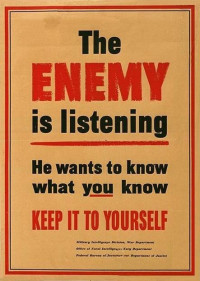Table of Contents
Laser Eavesdropping
~~META: status = suspended &relation firstimage = :project:enemy_listening.jpg ~~
Project status
Some experiments have been conducted with photo transistor, 250mW laser, mirrors and a custom A-class amplifier. The device is not very sensitive. It can capture when people are talking near the window.
Further research should consider using modulated beam and either analogue demodulator, or direct sampling with something faster than a soundcard and then software-based demodulation.
The Laser Spy System is considered by many to be the Holy Grail of high tech spy devices because it can give the user the ability to listen in on conversations that take place in a distant building without having to install a bug or transmitter at the location. The Laser Spy System was said to be invented in the Soviet Union by Leon Theremin in the late 1940s. Using a non-laser based infrared light source, Theremin's system could detect sound from a nearby window by picking up the faint vibrations on the glass surface. The KGB later used this device to spy on the British, French and US embassies in Moscow. It is also interesting to note that Leon Theremin invented the world's first electronic instrument, a wand operated synthesizer named “The Theremin” after him. (quote)
Progress
Jenda Dokážu na dva metry poslouchat zvuk z reproduktoru s přidělaným zrcátkem. Pokud použiju jako reflektor okno a mluvím přímo na něj, je docela slyšet (posloucháno ze vzdálenosti 4 metry - v brmlabu od paskystolu na ASRG postel). Jsem limitován rozměry místnosti a tak vychylování paprsku v řádu úhlových vteřin nevyrobí dostatečné absolutní délkové rozdíly. Bohužel klimatické podmínky nebyly nakloněny testování venku.
- Výsledek, posloucháno ze vzdálenosti 2 m.
Pouhé svícení laserem do fototranzistoru působí značné rušení, vůbec nevím, čím by to mohlo být způsobeno.Ani obrovské blokovací kondenzátory laboratorního zdroje nejsou pro tak choulostivou součástku (hlavně s šíleně nelineární proud-výkon charakteristikou) jako je polovodičový laser dostatečné. Při napájení laseru z baterie je výsledek mnohem lepší.
Interferometrický odposlouchávač
Tahle konstrukce má tu nevýhodu, že musíme mít dva body v rovině odposlouchávané místnosti. b00lean přednesl následující: stoupneme si kolmo k oknu, posvítíme na něj a necháme odraz dopadat zase na nás. Nyní vhodnou optikou budeme muxovat
- část vysílaného svazku
- přijatý svazek
Podle toho, jak zrovna vyjdou půlvlny světla se nám to buď vyruší nebo naopak sečte (nebo něco mezi). No a teď za oknem někdo mluví a jak se chvěje skleněná tabulka, tak se mění její vzdálenost od nás. A tak dochází k fázovému posunu v přijímaném paprsku a ten pak interferuje trochu jinak atd. Takto jsme schopni změřit nuance zhruba 100 nm. Popsal jsem to použitelně?
Documentation
Schematics
Inspiration
simplest: 7bSG3ThL2L8 final: cC8VnM3VtvY

